Risk Assessment for Energy Stations Based on Real-Time Equipment Failure Rates and Security Boundaries
Abstract
:1. Introduction
2. DESs and Security Risk
2.1. DESs
2.2. Security Risk Assessment
3. Security Boundary Analysis Based on Mutual Backup Relationships
3.1. Hypothetical Accident Set
3.2. Constraint on Multi-Energy Flow Balance
3.2.1. Power System Energy Balance Equation
3.2.2. Gas System Energy Balance Equation
3.2.3. Thermal System Energy Balance Equation
3.3. Boundary Analysis Based on Mutual Standby Relationships
3.3.1. Probability of Renewable Energy Contribution
3.3.2. Power System Boundary Analysis
3.3.3. Thermal System Boundary Analysis
3.3.4. Natural Gas System Boundary Analysis
3.3.5. Boundary Solving
4. Methodology for Assessment of DES Security Risks
4.1. Risk Source-Based Failure Analysis
4.1.1. Failure Analysis Based on Equipment Health Status
4.1.2. Failure Analysis Based on Weather Factors
4.1.3. Failure Analysis of Other Risk Sources
4.1.4. Equipment Failure Probability Model
4.2. Risk Assessment Methodology
5. Security Optimization Response Strategy
5.1. Impact of Energy Storage Access on the Boundary
5.2. Energy Storage Configuration Strategy
6. Example Analysis
6.1. Risk Assessment of Critical Equipment for Energy Stations
6.2. Transmission Pipeline Risk Assessment
6.3. Renewable Energy Access
6.4. Security Optimization Response Strategy
6.5. Contrast Analysis
7. Conclusions
- (1)
- As the coupling between different energy sources deepens, the transferability of faults among different energy sources poses challenges to the operational safety of distributed energy stations. Research on N-1 fault risk assessment methods and response strategies by the operators of DES, who are the actual decision-makers and beneficiaries, can enhance operational reliability and stability.
- (2)
- The proposed method effectively improves the efficiency of safety risk assessment calculations. By analyzing the mutual backup relationships between different devices and pipelines and constructing the DES safety boundary model, real-time online data assessment of operational status based on offline data are achieved. Compared to traditional online simulation methods, this method enhances computational efficiency.
- (3)
- Variations in renewable energy output lead to changes in relevant equipment safety boundaries. Due to the stochastic nature of renewable energy output, the safety boundaries of related equipment relying on renewable energy as backup power become uncertain. However, this uncertainty is also constrained by the network structure at connection points.
- (4)
- The real-time calculation method for equipment failure probabilities proposed in this paper better matches actual equipment conditions. By considering the multi-risk characteristics of equipment health status, weather conditions, and other fault sources, a multi-risk source-based equipment failure probability model is constructed, making it more aligned with actual equipment conditions. Algorithm analysis demonstrates that the proposed method accurately quantifies the operational risks of energy stations.
- (5)
- For high-risk nodes, an energy storage optimization response strategy considering both economic and safety aspects is proposed, effectively reducing energy storage configuration costs and enhancing the operational safety and reliability of energy stations. This provides a reference for the planning and operation of energy stations.
- (6)
- In the future, more in-depth consideration will be given to safety risk response strategies and their application in practical engineering to validate their correctness.
Author Contributions
Funding
Institutional Review Board Statement
Informed Consent Statement
Data Availability Statement
Conflicts of Interest
Appendix A
| Symbol | Meaning | Symbol | Meaning |
|---|---|---|---|
| L | the energy station operating state observation | m | the natural gas consumption flow rate of the gas boiler |
| Pi | the active power of the ith node | the sum of the power outputs of the transmission outlet pipeline connected to the mutual standby related equipment | |
| Qi | the reactive power of the ith node | the sum of the power required for the normal operation of the coupled equipment (including circulating pumps, compressors, etc.) | |
| Gij | the conductance between nodes i and j | the sum of the power outputs of the lower pipeline of the transmission outlet pipeline | |
| Bij | the susceptance between nodes i and j | P | the power outputs of photovoltaic power generation |
| θij | the phase angle difference between nodes i and j | W | the power outputs of wind power generation |
| CCHP | the thermal-to-electric ratio of the CHP unit | the sum of the standby outputs of other equipment under conditions of failure of the equipment | |
| PCHP,h | the thermal power outputs | the capacity of the mth backup equipment connected to the pipeline capacity | |
| PCHP,e | the electric power outputs | the capacity of the mth of backup equipment connected to the pipeline capacity | |
| fij | the flow from node i to node j | Sicom | the output power of the ith mutually incompatible backup mode |
| kij | the pipe coefficient | ΣSi | the sum of the outputs of the backup modes without competing relationships |
| K | the compression ratio | the noncompetitive relationship of backup mode equipment capacity | |
| C | the coefficient related to temperature and efficiency | the noncompetitive relationship backup mode the pipeline capacity | |
| a | variable coefficient | Licom | the ith mutually noncompetitive relationship backup mode pipeline |
| Qa | the compressor flow rate | kw | the shape factor |
| B | the correlation matrix of the network | cw | the scale factor |
| m | the branch flow vector | Vr | the rated wind |
| Kg | the pipe coefficient | Vh | the actual wind speed |
| f | the pipe friction | Vout | the cut-out wind speed |
| D | the pipe diameter | Vin | the cut-in wind speed |
| ρ | the density of the medium | Pwmax | the maximum output power of the fan |
| Cw | the specific heat capacity of the medium | ap | the shape factors |
| To | the outlet water temperatures | βp | the scale factors |
| Ti | the return water temperatures | Sh | the actual light intensities |
| Ta | the ambient temperature | Sr | the rated light intensities |
| λ | the heat transfer coefficient. | Li | the Load carried by the ith pipeline |
| η | the efficiency of the circulation pump | CLi | the capacity of the ith pipeline |
| pout | the outlet pressures of the medium | Ti | the Transformer i |
| pin | the inlet pressures of the medium | CTi | the capacity of the ith transformer |
| ρ | density of the medium | CGB | the capacity of gas boilers |
| PGB | the power output of the gas boiler | CCPi | the capacity of the ith circulation pump |
| β | the boiler efficiency | CCi | the capacity of the ith compressor |
| H | the average heating value of natural gas | ai | proportionality factor |
| bi | curvature factor | fmax | the maximum failure rate |
| fmin | minimum failure rate | fav | average failure rate |
| Smin | the worst state ratings of the equipment | Sav | the average state ratings of the equipment |
| Smax | the best state ratings of the equipment | fj,w | The failure frequency model based on weather factors |
| fj,av | the average failure frequency of the jth piece of equipment | Nj | the duration of normal weather conditions |
| Uj | the duration of bad weather conditions | Kj | the proportion of equipment failures during bad weather |
| fj,e | the failure model of other risk sources | nj,i | the number of failures of the jth piece of equipment |
| Nj,i | the time duration of the ith state | Kj | the proportion of failed equipment during bad weather |
| ∆t | the measurement period | feq | the frequency of failure based on equipment status |
| fw | the frequency of failure based on weather conditions | fe | the frequency of failure from other risk sources |
| R | the security risk index | Fj(∆t) | the probability that the jth piece of equipment fails |
| rj | the degree of deactivation following the failure of this equipment | O | a point within the boundary |
| C0 | the state point on the boundary | Cj | the real-time state point |
| ES | the power of the energy storage equipment | F1 | the economic function |
| F2 | the security function | ρ | the discount rate |
| r | the service life | the cost per unit capacity | |
| the capacity of the energy storage equipment | the cost per unit power | ||
| the power output of the energy storage equipment | the value of the security risk index following energy storage configuration | ||
| R0 | the value of the security risk index before energy storage configuration | the lower limits of the capacity of the energy storage equipment | |
| the upper limits of the capacity of the energy storage equipment | the maximum capacity of the pipeline connected to the energy storage equipment | ||
| Rmax | the maximum risk acceptable for the energy supply of the energy station. |
Appendix B

Appendix C
| Equipment | Equipment Parameters | Equipment Capacity | |
|---|---|---|---|
| DES 1 | PV | Shape factor: 0.79 Scale factor: 1.87 Rated light intensity: 700 | Total photovoltaic capacity: 4 MW |
| T | T1: 35/11 kV T2: 35/11 kV | T1: 5 MVA T2: 6 MVA | |
| GB | Energy conversion efficiency: 0.9 | 6 MW | |
| C1, C2 | boost ratio: 1.2 | 6 MW | |
| CHP | CCHP,min: 1.5 CCHP,max: 10 | Electrical capacity: 3 MW Heat capacity: 4 MW | |
| DES 2 | WTG | Scale factor: 2.15 Shape factor: 15 Cut-in wind speed: 4 m/s Rated wind speed: 15 m/s Cut-out wind speed: 25 m/s | Total fan capacity: 4 MW |
| Transformer | T3: 35/11 kV T4: 35/11 kV | T3: 6 MVA T4: 6 MVA | |
| Compressor | C1 Boost ratio: 1.20 C2 Boost ratio: 1.20 | 6 MW | |
| Key Pipelines | Power pipelines I | (L1, L2, L10, L7) Voltage rating: 10 kV | Capacity: 6.31 MVA |
| Power pipelines II | (L3, L4) Voltage rating: 10 kV | Capacity: 7.5 MVA | |
| Heat network pipeline | Water supply temperature: 100 °C Water supply temperature: 49–50 °C | Capacity: 89.81 m3/h | |
| Natural gas pipeline | Sub-pressure natural gas pipeline network pressure: 0.8~1.6 MPa | 0.334 MMCFD2 |
| Line | Length | Failure Probability Model |
|---|---|---|
| L1 | 800 m | |
| L2 | 860 m | |
| L3 | 700 m | |
| L4 | 1300 m | |
| L5 | 900 m | |
| L6 | 950 m | |
| L7 | 750 m | |
| L8 | 1600 m | |
| L9 | 1760 m | |
| L10 | 400 m |
| Equipment Status | Scenario I | Scenario II | Scenario III |
|---|---|---|---|
| L1 | 80 | 80 | 70 |
| L2 | 80 | 80 | 90 |
| L3 | 80 | 80 | 90 |
| L4 | 80 | 80 | 90 |
| L5 | 80 | 80 | 70 |
| L6 | 80 | 80 | 70 |
| L7 | 80 | 80 | 90 |
| L8 | 80 | 80 | 70 |
| L9 | 80 | 80 | 80 |
| L10 | 80 | 80 | 60 |
| Weather | Good | Bad | Good |
References
- Jiang, F.; Peng, X.; Tu, C.; Guo, Q.; Deng, J.; Dai, F. An improved hybrid parallel compensator for enhancing PV power transfer capability. IEEE Trans. Ind. Electron. 2021, 69, 11132–11143. [Google Scholar] [CrossRef]
- Jiang, F.; Tu, C.; Guo, Q.; Shuai, Z.; He, X.; He, J. Dual-functional dynamic voltage restorer to limit fault current. IEEE Trans. Ind. Electron. 2018, 66, 5300–5309. [Google Scholar] [CrossRef]
- Liang, X.; Jiang, F.; Peng, X.; Xiong, L.; Jiang, Y.; Gautam, S.; Li, Z. Improved Hybrid Reactive Power Compensation System Based on FC and STATCOM and Its Control Method. Chin. J. Electr. Eng. 2022, 8, 29–41. [Google Scholar] [CrossRef]
- Qiu, Y.; Li, Q.; Ai, Y.; Chen, W.; Benbouzid, M.; Liu, S.; Gao, F. Two-stage distributionally robust optimization-based coordinated scheduling of integrated energy system with electricity-hydrogen hybrid energy storage. Prot. Control. Mod. Power Syst. 2023, 81, 33. [Google Scholar] [CrossRef]
- Negnevitsky, M.; Nguyen, D.H.; Piekutowski, M. Risk assessment for power system operation planning with high wind power penetration. IEEE Trans. Power Syst. 2014, 30, 1359–1368. [Google Scholar] [CrossRef]
- Li, X.; Zhang, X.; Wu, L.; Lu, P.; Zhang, S.H. Transmission line overload risk assessment for power systems with wind and load-power generation correlation. IEEE Trans. Smart Grid 2015, 6, 1233–1242. [Google Scholar] [CrossRef]
- Luo, J.; Li, H.; Wang, S. A quantitative reliability assessment and risk quantification method for microgrids considering supply and demand uncertainties. Appl. Energy 2022, 328, 120130. [Google Scholar] [CrossRef]
- Laowanitwattana, J.; Uatrongjit, S. Probabilistic power flow analysis based on partial least square and arbitrary polynomial chaos expansion. IEEE Trans. Power Syst. 2021, 37, 1461–1470. [Google Scholar] [CrossRef]
- Xia, S.; Song, L.; Wu, Y.; Ma, Z.J.; Jing, J.P.; Ding, Z.H.; Li, G.Y. An integrated LHS–CD approach for power system security risk assessment with consideration of source–network and load uncertainties. Processes 2019, 7, 900. [Google Scholar] [CrossRef]
- Ye, K.; Zhao, J.; Zhang, H.; Zhang, Y.C. Data-driven probabilistic voltage risk assessment of miniwecc system with uncertain PVs and wind generations using realistic data. IEEE Trans. Power Syst. 2022, 37, 4121–4124. [Google Scholar] [CrossRef]
- Urbanik, M.; Tchórzewska-Cieślak, B.; Pietrucha-Urbanik, K. Analysis of the safety of functioning gas pipelines in terms of the occurrence of failures. Energies 2019, 12, 3228. [Google Scholar] [CrossRef]
- Nemet, A.; Klemeš, J.J.; Moon, I.; Kravanja, Z. Safety analysis embedded in heat exchanger network synthesis. Comput. Chem. Eng. 2017, 107, 357–380. [Google Scholar] [CrossRef]
- Cao, M.; Shao, C.; Hu, B.; Xie, K.G.; Li, W.Y.; Peng, L.B.; Zhang, W.X. Reliability assessment of integrated energy systems considering emergency dispatch based on dynamic optimal energy flow. IEEE Trans. Sustain. Energy 2021, 13, 290–301. [Google Scholar] [CrossRef]
- Mu, Y.; Wang, C.; Cao, Y.; Jia, H.J.; Zhang, Q.Z.; Yu, X.D. A CVAR-based risk assessment method for park-level integrated energy system considering the uncertainties and correlation of energy prices. Energy 2022, 247, 123549. [Google Scholar] [CrossRef]
- Wang, C.; Yan, C.; Li, G.; Liu, S.Y.; Bie, Z.H. Risk assessment of integrated electricity and heat system with independent energy operators based on Stackelberg game. Energy 2020, 198, 117349. [Google Scholar] [CrossRef]
- Zhang, Y.; Yang, Z.; Ji, X.; Zhang, X.; Yu, Z.H.; Wu, F.C. Robust optimization of the active distribution network involving risk assessment. Front. Energy Res. 2022, 10, 963576. [Google Scholar] [CrossRef]
- Xie, H.; Chen, H.; Deng, X.; Zhang, P.; Sun, Q. Electric-gas integrated energy system operational risk assessment based on improved k-means clustering technology and semi-invariant method. Proc. CSEE 2020, 40, 59–69. [Google Scholar] [CrossRef]
- Wang, D.; Li, S.; Jia, H.; Xiao, J.; Guo, Y. Research on interval security region of regional integrated energy system integrated with renewable energy sources, part I: Concepts, modeling and dimension reduction observation. Proc. CSEE 2022, 42, 3188–3204. [Google Scholar] [CrossRef]
- Chen, S.; Wei, Z.; Sun, G.; Wei, W.; Wang, D. Convex hull based robust security region for electricity-gas integrated energy systems. IEEE Trans. Power Syst. 2018, 34, 1740–1748. [Google Scholar] [CrossRef]
- Shi, J.; Wang, Y.; Fu, R.; Zhang, J. Operating strategy for local-area energy systems integration considering uncertainty of supply-side and demand-side under conditional value-at-risk assessment. Sustainability 2017, 9, 1655. [Google Scholar] [CrossRef]
- Zong, X.; Yuan, Y. Two-stage robust optimization of regional integrated energy systems considering uncertainties of distributed energy stations. Front. Energy Res. 2023, 11, 1135056. [Google Scholar] [CrossRef]
- Cherdantseva, Y.; Burnap, P.; Blyth, A.; Eden, P.; Jones, K.; Soulsby, H.; Stoddart, K. A review of cyber security risk assessment methods for SCADA systems. Comput. Secur. 2016, 56, 1–27. [Google Scholar] [CrossRef]
- Xiao, J.; Lin, X.; Jiao, H.; Song, C.; Zhou, H.; Zu, G.; Wang, D. Model, calculation, and application of available supply capability for distribution systems. Appl. Energy 2023, 348, 121489. [Google Scholar] [CrossRef]
- Liu, L.; Wang, D.; Hou, K.; Jia, H.J.; Li, S.Y. Region model and application of regional integrated energy system security analysis. Appl. Energy 2020, 260, 114268. [Google Scholar] [CrossRef]
- Zhou, B.; Fang, J.; Ai, X.; Yao, W.; Chen, Z.; Wen, J. Pyramidal approximation for power flow and optimal power flow. IET Gener. Transm. Distrib. 2020, 14, 3774–3782. [Google Scholar] [CrossRef]
- Ding, T.; Jia, W.; Shahidehpour, M. A convex energy-like function for reliable gas flow solutions in gas transmission systems. IEEE Trans. Power Syst. 2021, 36, 4876–4879. [Google Scholar] [CrossRef]
- Gomariz, F.P.; López, J.M.C.; Munoz, F.D. An analysis of low flow for solar thermal system for water heating. Sol. Energy 2019, 179, 67–73. [Google Scholar] [CrossRef]
- Zhang, S.; Cheng, H.; Li, K.; Tai, N.; Wang, D.; Li, F. Multi-objective distributed generation planning in distribution network considering correlations among uncertainties. Appl. Energy 2018, 226, 743–755. [Google Scholar] [CrossRef]
- Ren, Z.; Yan, W.; Zhao, X.; Li, W.; Yu, J. Chronological probability model of photovoltaic generation. IEEE Trans. Power Syst. 2013, 29, 1077–1088. [Google Scholar] [CrossRef]
- Shi, C.; Ning, X.; Sun, Z.; Kang, C.; Du, Y.; Ma, G. Quantitative risk assessment of distribution network based on real-time health index of equipment. High Volt. Eng. 2018, 44, 534–540. [Google Scholar] [CrossRef]
- Brown, R.E.; Frimpong, G.; Willis, H.L. Failure Rate Modeling Using Equipment Inspection Data. IEEE Trans. Power Syst. 2004, 19, 782–787. [Google Scholar] [CrossRef]
- Wang, Y.; Chen, L.; Yao, M.; Li, X. Evaluating weather influences on transmission line failure rate based on scarce fault records via a bi-layer clustering technique. IET Gener. Transm. Distrib. 2019, 13, 5305–5312. [Google Scholar] [CrossRef]
- Zhang, X.; Zheng, X.; Cheng, R.; Qiu, J.; Jin, Y. A competitive mechanism based multi-objective particle swarm optimizer with fast convergence. Inf. Sci. 2018, 427, 63–76. [Google Scholar] [CrossRef]
- Guo, Y.; Wang, D.; Li, S.; Jia, H.; Li, J.; Zheng, Y.; Yang, Z. Optimal allocation of energy storage in regional integrated energy system based on security region. Power Syst. Technol. 2022, 46, 604–612. [Google Scholar] [CrossRef]
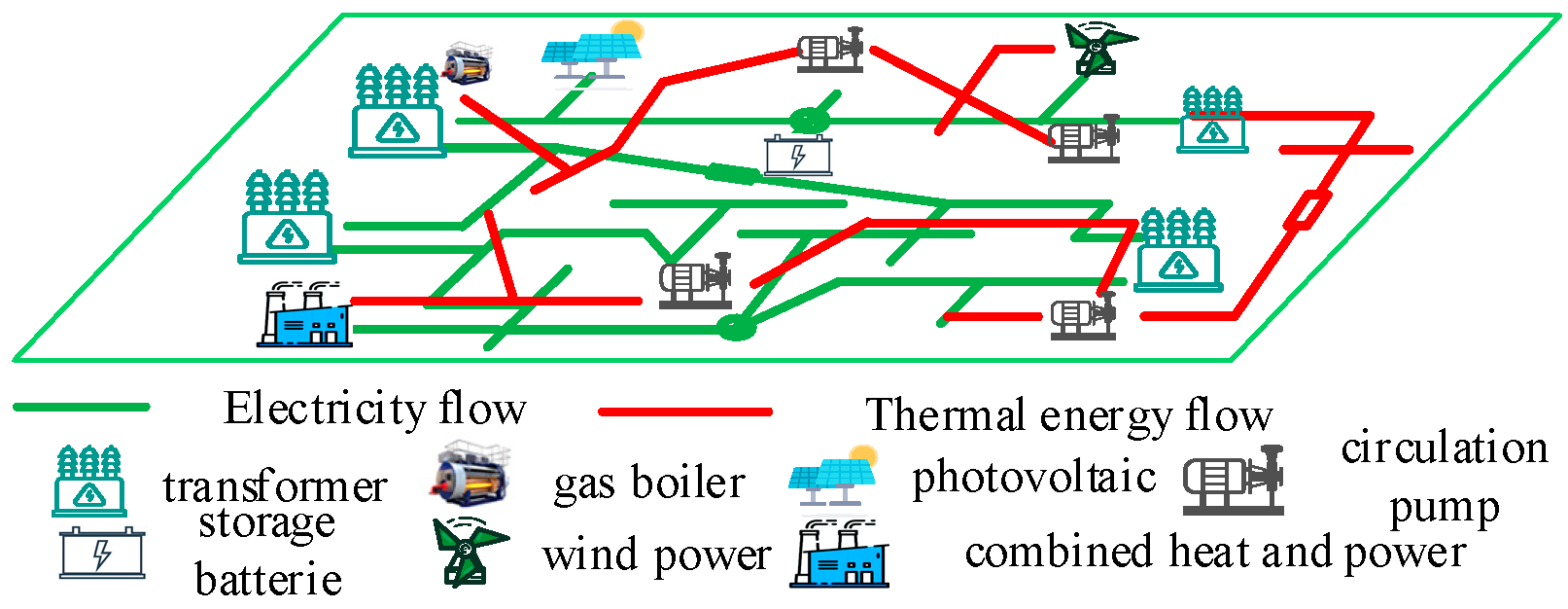
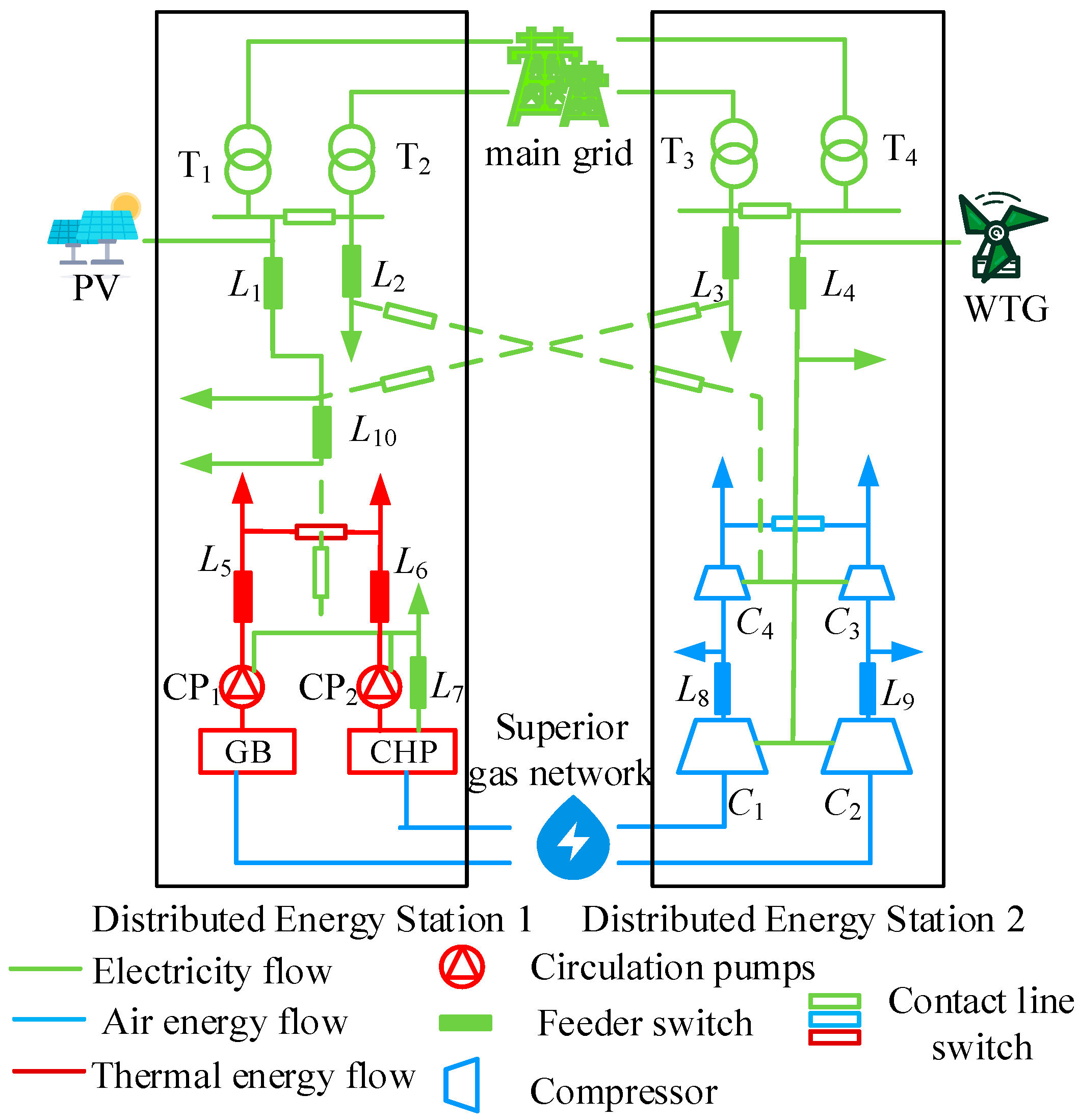
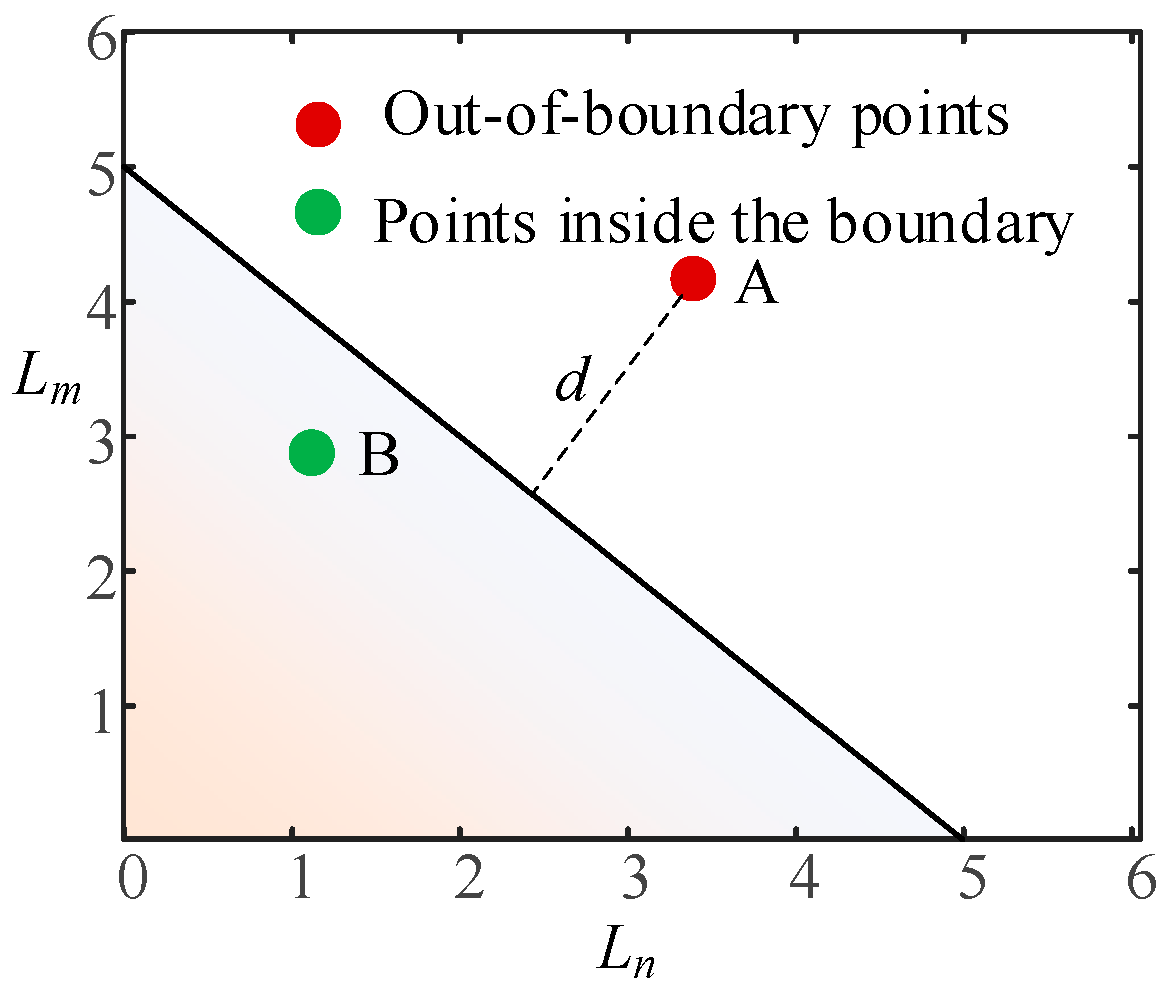
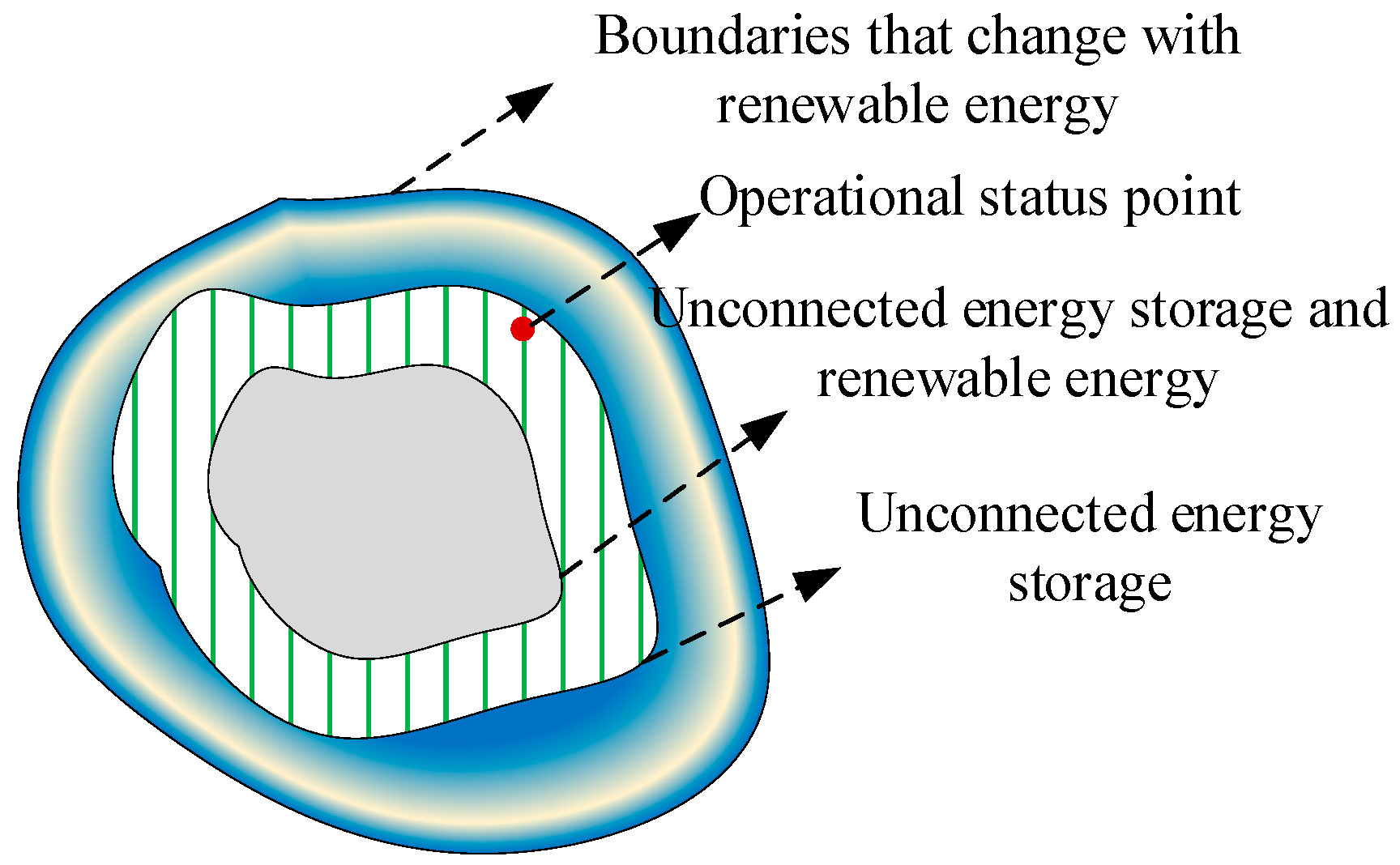

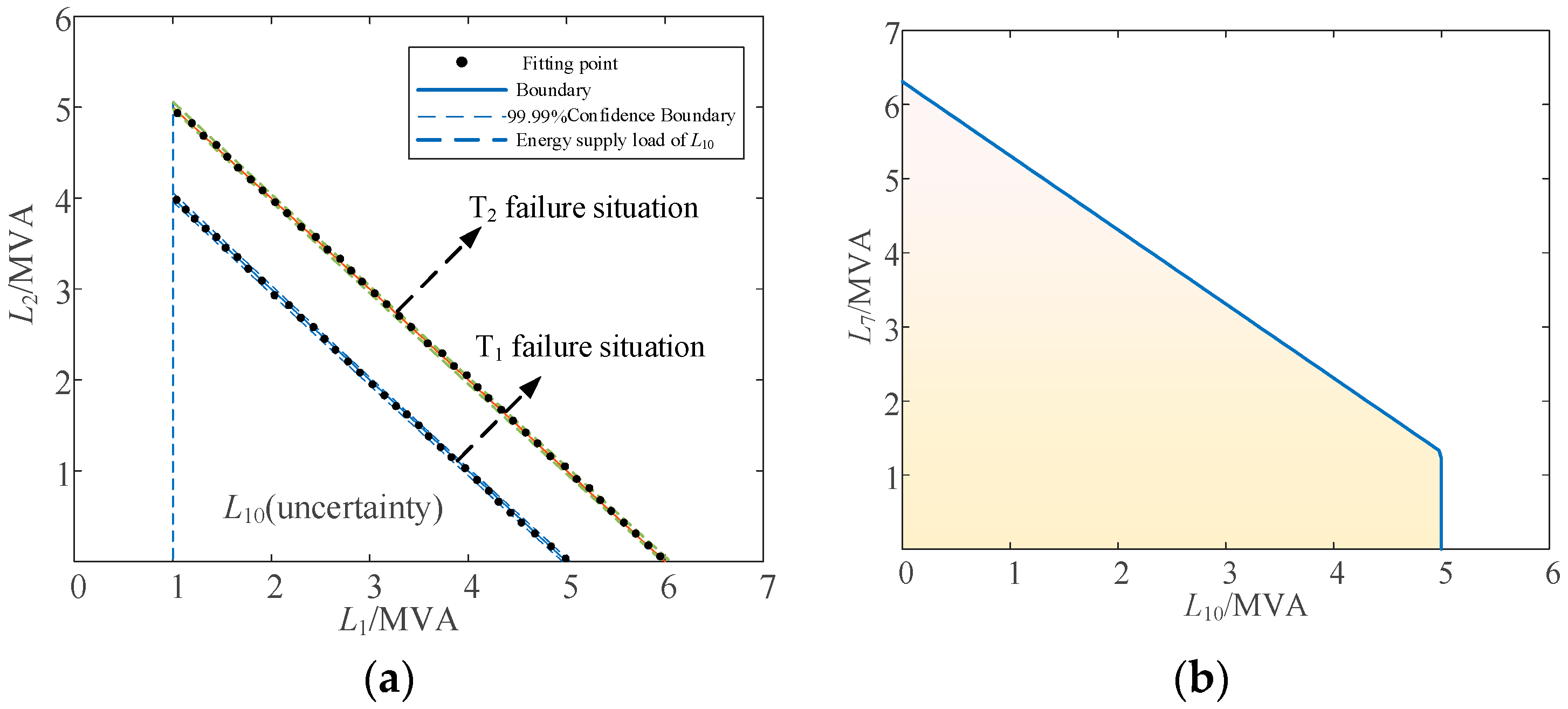
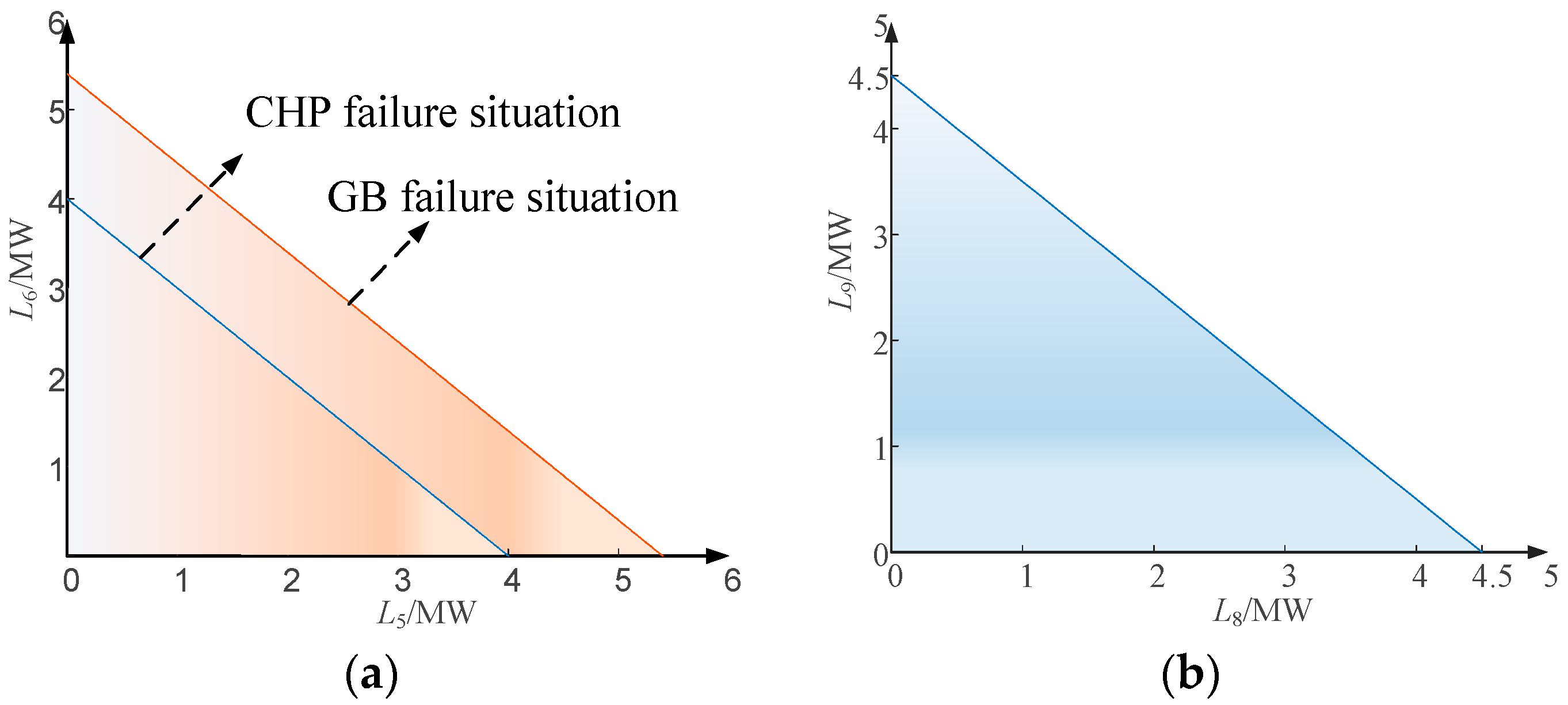
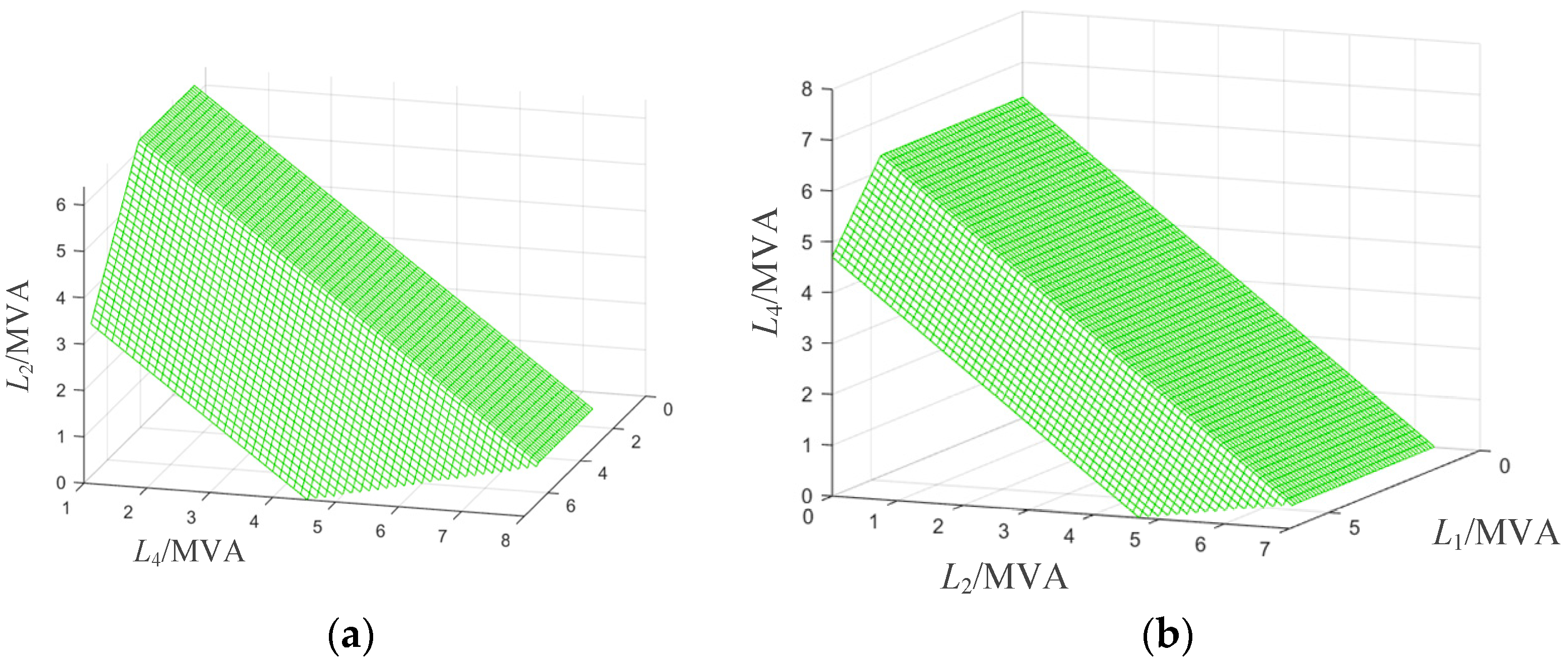

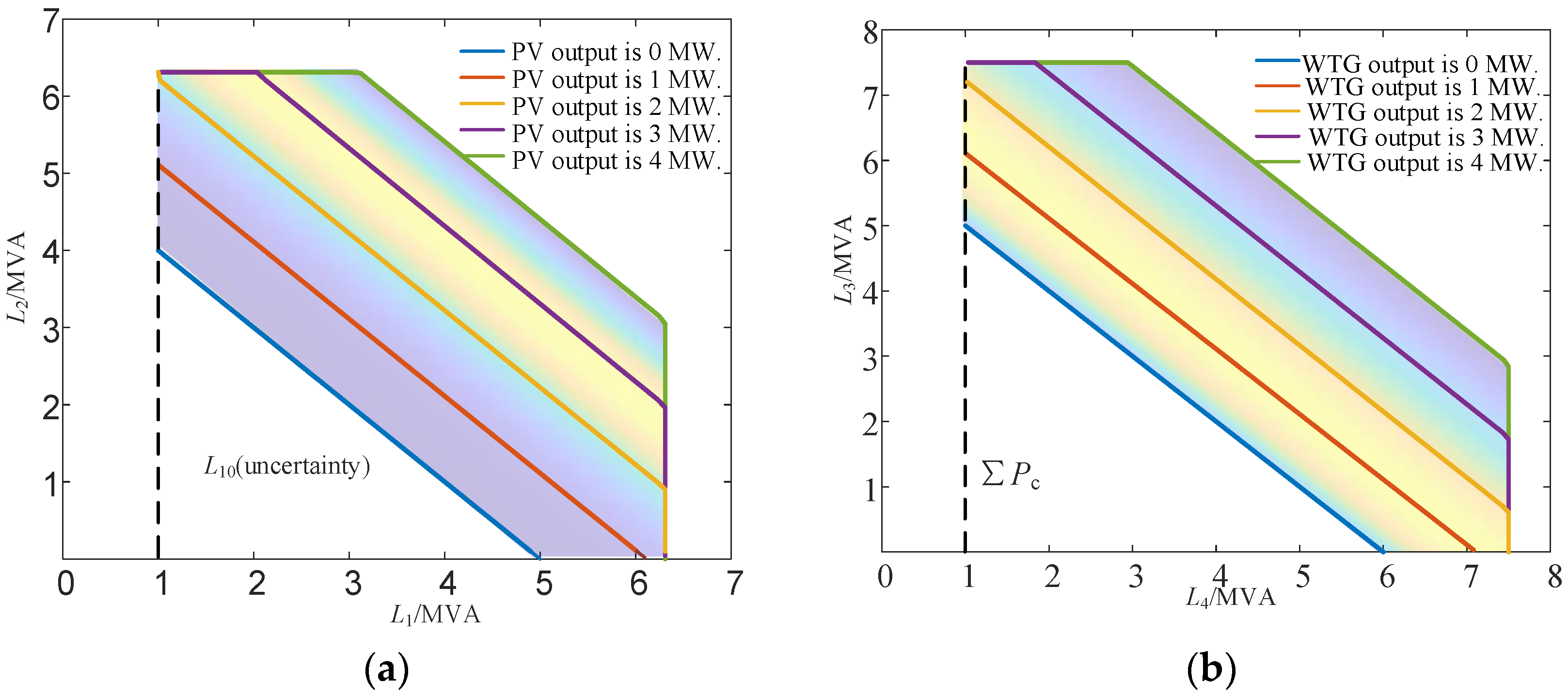
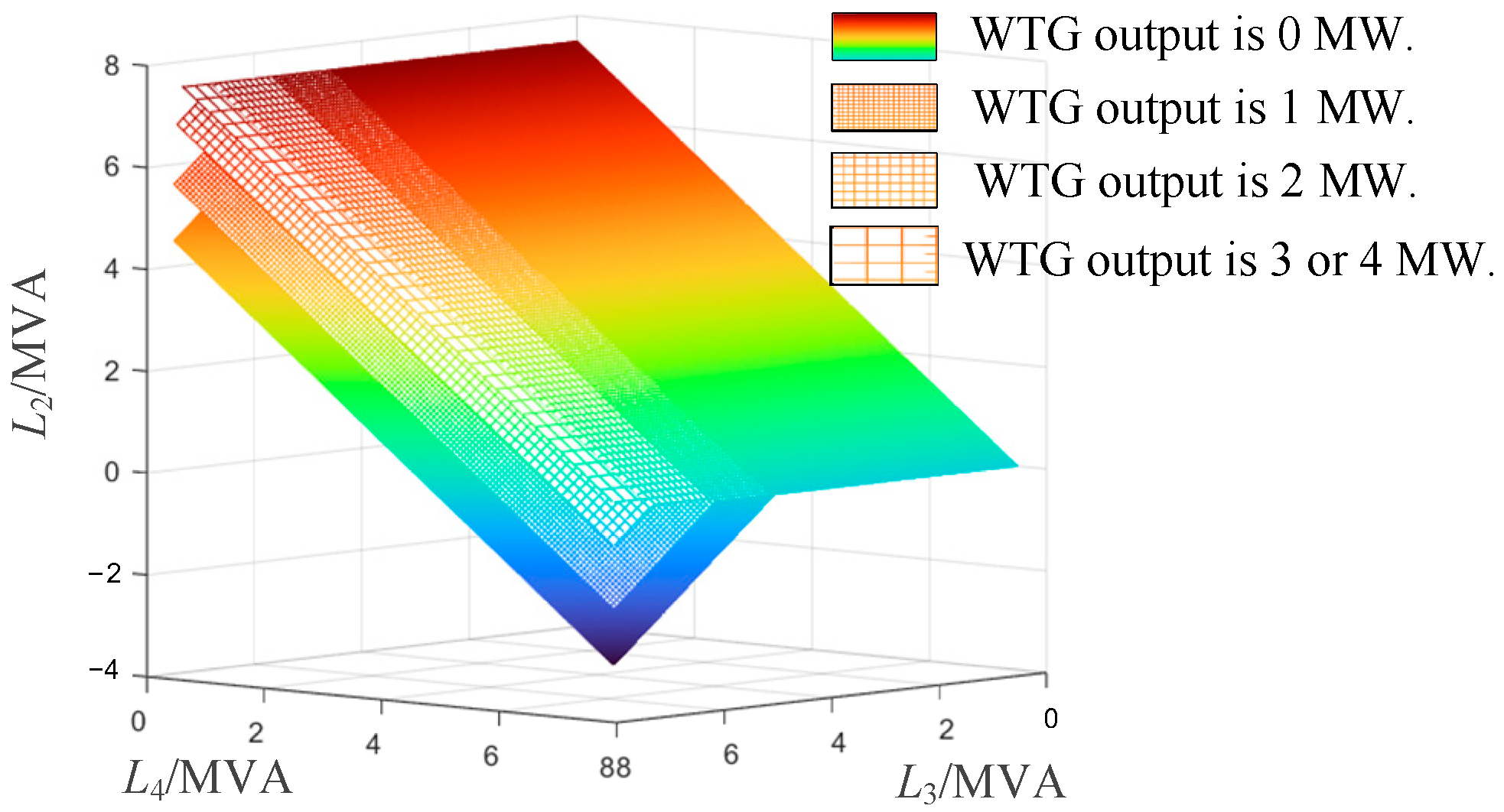

| Key Equipment | Average Failure Frequency | Key Equipment | Average Failure Frequency |
|---|---|---|---|
| Transmission pipeline | 0.071 | Gas pipeline | 0.085 |
| Heating pipeline | 0.077 | Transformer | 0.015 |
| CHP unit (with circulation pump) | 0.065 | GB unit(including circulation pump) | 0.075 |
| Compressor | 0.05 |
| Outdoor Equipment | Failure Frequency | |
|---|---|---|
| Normal Weather | Bad Weather | |
| Transmission pipeline | 0.025 | 1.603 |
| Transformer | 0.006 | 0.309 |
| Failure Equipment | Equipment Status | Failure Probability | Loss of Load Level | Risk Assessment |
|---|---|---|---|---|
| T1 | 80 | 1.0274 × 10−5 | 2.088 MVA | 21.45 |
| T2 | 85 | 6.5194 × 10−6 | 1.088 MVA | 7.093 |
| T3 | 80 | 1.0274 × 10−5 | 0.278 MVA | 2.856 |
| T4 | 85 | 6.5194 × 10−6 | 0.278 MVA | 1.812 |
| GB | 80 | 5.1369 × 10−5 | 0.26 MW | 13.355 |
| CHP | 80 | 4.452 × 10−5 | heat 0 MW electronic 0 MVA | 0 |
| C1 | 80 | 3.4246 × 10−5 | 0.03 MW | 1.0273 |
| C2 | 90 | 1.3709 × 10−5 | 0.03 MW | 0.4112 |
| Failure Pipeline | Equipment Status | Failure Probability | Loss of Load Level | Risk Assessment |
|---|---|---|---|---|
| L1 | 80 | 3.8903 × 10−5 | 0 | 0 |
| L2 | 80 | 4.1821 × 10−5 | 0 | 0 |
| L3 | 80 | 3.4041 × 10−5 | 0 | 0 |
| L4 | 80 | 6.3217 × 10−5 | 0.667 MVA | 42.1657 |
| L5 | 80 | 4.7465 × 10−5 | 0.26 MW | 12.34 |
| L6 | 80 | 5.0101 × 10−5 | 0 | 0 |
| L7 | 80 | 3.6472 × 10−5 | 0 | 0 |
| L8 | 80 | 9.314 × 10−5 | 0.03 MW | 2.7942 |
| L9 | 80 | 1.0246 × 10−4 | 0.03 MW | 3.0738 |
| L10 | 80 | 1.0274 × 10−5 | 1.677 MVA | 17.229 |
| Configuration Option | Risk Value | Cost/CNY | Power | Capacity |
|---|---|---|---|---|
| Configuration I | 0 | 34,841 | 0.667 MW | 1.4822 MWh |
| Configuration II | −200 | 2,001,100 | 3.831 MW | 8.513 MWh |
| Configuration III | −431.96 | 6.5135 × 106 | 7.5 MW | 30.763 MWh |
| Line | Scenario I (×10−5) | Scenario II (×10−5) | Scenario III (×10−5) | |||
|---|---|---|---|---|---|---|
| Method I | Method II | Method I | Method II | Method I | Method II | |
| L1 | 3.8903 | 3.8903 | 3.8903 | 91.683 | 3.8903 | 9.5595 |
| L2 | 4.1821 | 4.1821 | 4.1821 | 98.556 | 4.1821 | 1.674 |
| L3 | 3.4041 | 3.4041 | 3.4041 | 80.228 | 3.4041 | 1.3626 |
| L4 | 6.3217 | 6.3217 | 6.3217 | 148.94 | 6.3217 | 2.5305 |
| L5 | 4.7465 | 4.7465 | 4.7465 | 4.7465 | 4.7465 | 11.664 |
| L6 | 5.0101 | 5.0101 | 5.0101 | 5.0101 | 5.0101 | 12.312 |
| L7 | 3.6472 | 3.6472 | 3.6472 | 85.956 | 3.6472 | 1.4599 |
| L8 | 9.314 | 9.314 | 9.314 | 9.314 | 9.314 | 14.233 |
| L9 | 10.246 | 10.246 | 10.246 | 10.246 | 10.246 | 2.7813 |
| L10 | 1.0274 | 1.0274 | 1.0274 | 45.852 | 1.0274 | 11.67 |
Disclaimer/Publisher’s Note: The statements, opinions and data contained in all publications are solely those of the individual author(s) and contributor(s) and not of MDPI and/or the editor(s). MDPI and/or the editor(s) disclaim responsibility for any injury to people or property resulting from any ideas, methods, instructions or products referred to in the content. |
© 2023 by the authors. Licensee MDPI, Basel, Switzerland. This article is an open access article distributed under the terms and conditions of the Creative Commons Attribution (CC BY) license (https://creativecommons.org/licenses/by/4.0/).
Share and Cite
Luo, Y.; Li, Z.; Li, S.; Jiang, F. Risk Assessment for Energy Stations Based on Real-Time Equipment Failure Rates and Security Boundaries. Sustainability 2023, 15, 13741. https://doi.org/10.3390/su151813741
Luo Y, Li Z, Li S, Jiang F. Risk Assessment for Energy Stations Based on Real-Time Equipment Failure Rates and Security Boundaries. Sustainability. 2023; 15(18):13741. https://doi.org/10.3390/su151813741
Chicago/Turabian StyleLuo, Yongheng, Zhonglong Li, Sen Li, and Fei Jiang. 2023. "Risk Assessment for Energy Stations Based on Real-Time Equipment Failure Rates and Security Boundaries" Sustainability 15, no. 18: 13741. https://doi.org/10.3390/su151813741






